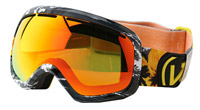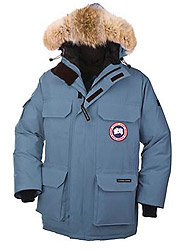 Modern
Antarctic Clothing
Modern
Antarctic Clothing
Extreme Cold Weather Clothing
Warm clothing for Antarctica or any cold conditions, these principles apply to anywhere when the temperature drops and the wind blows. The "layer method" of dressing is more effective than a single bulky garment. Several layers are built up, each of which has its own part to contribute, insulating air is trapped between as well as within layers, flexibility is maintained as conditions change.
![]()
![]() This is the Australia & New Zealand page
This is the Australia & New Zealand page
UK page
![]() | US page
| US page
![]()
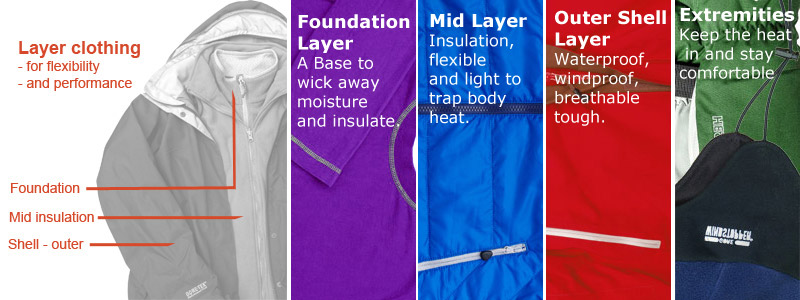
Foundation / Base Layer
The layer next to the skin, this should be soft, comfortable and able to wick away perspiration quickly so leaving you feeling dry in spite of your exertions in the cold. Moisture in clothing will also reduce the insulation, so it is important to get sweat away from your skin and away from your clothes so breathability is of the utmost importance. To function most efficiently the foundation layer should be close fitting to the body. A versatile layer, tops can be used as your outer layer indoors and help keep you toasty outdoors. Long johns go under thick, warm pants (trousers). It's unlikely you'll need any long underwear for your legs in the Antarctic summer in coastal regions, unless you really do suffer from the cold. If you're not going to an extreme climate but the extreme climate has temporarily come to you, a good thermal long underwear layer along with a hat, gloves, warm socks, thermal insoles and scarf or neck gaiter are the cheapest way of effectively dealing with the short-term conditions such as transport between home and work-place or wherever you need to go. The gold standard of thermal underwear is
merino wool, not a budget option but it really
does deliver performance-wise. A soft and fine natural
product, the wool of the merino sheep, very good at
wicking sweat from the skin surface and naturally odor
resistant. Buy Synthetic: Men's Tops | Men's Bottoms | Women's Bottoms | Kids Bottoms |
Wind chill - the commonest reason that I see people being cold in cold conditions is that they don't take enough consideration of the effects of the wind. Ensuring that the outer layer is made of properly windproof material rather than something that invites the wind in for a good blow around can make all the difference and can reduce the amount of clothing that you need overall.
At warmer temperatures, the wind makes little or no difference. As the temperature falls the wind begins to have a disproportionate effect. The table shows the effect that the wind speed has on apparent temperature, the numbers in the blue section are the equivalent reduction in temperature at that point.
The colder it gets, the greater the cooling effect of the wind, even if it's no stronger.
| Windchill
reduction in degrees C |
Ambient Temperature C | ||||||
| 0 | -5 | -10 | -15 | -20 | -25 | ||
| Wind speed kmh |
10 | 3 | 4 | 5 | 6 | 7 | 8 |
| 20 | 5 | 7 | 8 | 9 | 10 | 12 | |
| 30 | 6 | 8 | 10 | 11 | 13 | 14 | |
| 40 | 7 | 9 | 11 | 12 | 14 | 16 | |
| 50 | 8 | 10 | 12 | 14 | 15 | 17 | |
| 60 | 9 | 10 | 13 | 15 | 16 | 18 | |
With a wind speed of 10kph at 0C, the wind effect is to cool by another 3 degrees to -3, by the time it's -25C, the same wind has a 8 degree effect to -33.
|
The Outer or Shell Layer - This layer provides direct weather protection, it must be windproof and may be waterproof depending on the temperature it will used at. It can be literally a "shell" or have additional insulation built in.  Outer
/ shell layer, this needs to be windproof and may be
waterproof, jackets should always have hoods
for cold conditions. Outer
/ shell layer, this needs to be windproof and may be
waterproof, jackets should always have hoods
for cold conditions.The outer layer is particularly important and should have features such as draw-cords and fastening cuffs to prevent warm air being lost to the outside and to prevent snow finding its way into nooks and crannies (snow in the cranny is most uncomfortable). Waterproof is not necessary for very cold weather as no rain falls, though if you intend to spend any time in boats waterproof is vital as you don't want to get ashore after bouncing over an excitable sea to find you are wet and cold for the rest of the day. 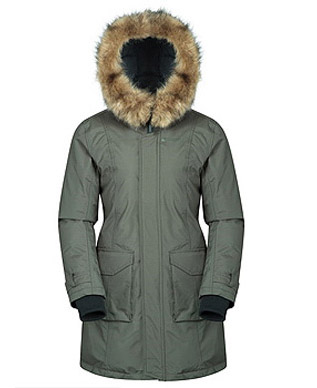 Women's - Aurora Extreme Down Jacket Breathable waterproof outer, feather and down filling 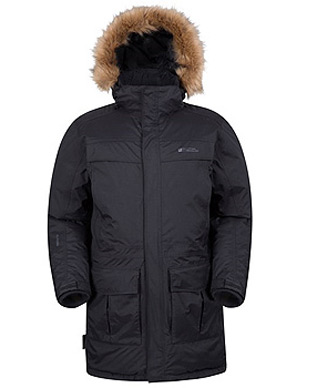 Men's - Antarctic Extreme Down Jacket Breathable waterproof outer, feather and down filling Fully waterproof garments are not as able to transmit perspiration as readily as garments that are not fully waterproof and tend not to be as soft and flexible at low temperatures, choose according to your intended use. Insulating materials for this outer layer where they are used can be synthetic or the traditional and arguably still the most effective - natural down.
|
|
Mid Insulation Layer/s - A versatile layer that provides insulation while being easy to put on or take off. Buttons, zips and the like allow for versatility of ventilation at rest, during exertion or to quickly close everything up when the weather worsens.
The most variable layer which and can be added to as required depending on how cold the conditions are. More than one lightweight layer of a shirt, sweater or jacket allows for flexibility by adding or removing according to weather and activity levels, they are also warmer than one thick heavy layer too as extra insulating air gets trapped between the layers as well as within them. Traditionally woolen sweaters and natural fiber pants were worn. These may still be used or they may be supplemented or substituted by more modern materials such as polypropylene fleece or lightweight down. 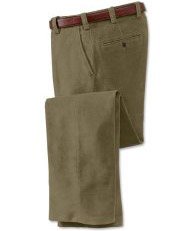 This layer should provide insulation while allowing ventilation and breathability for the passage and release of perspiration. Insulating Layers for the Upper Body Wool mix or synthetic shirt, woolen sweater, fleece or down sweater and /or jacket. Adjustability is important here, zips, buttons etc. At least one of these layers should be long at the back to avoid exposure of flesh during exertion. The insulating layer can be combined with the wind-proof or water-proof outer layer or could be separate. Don't be tempted to think that you will be able to get away with a fleece as your only outer layer however, despite new coatings and finishes, they just aren't wind or water-proof enough on their own. You might prefer a down-filled parka, while these are extremely warm and can easily be thrown on over a t-shirt for immediate serious insulation, they can be inflexible in terms of layer dressing when walking ashore, go for a more versatile light-weight one. Long-sleeved tops and pullovers - Men's Women's Insulating Layers for the Lower BodyThick warm trousers of a natural material such as moleskin or heavyweight synthetic material such as polyester or nylon. I have worn moleskin (a kind of cotton, named for its texture and not made from either the skin or kin of moles) pants in both polar regions and wouldn't consider wearing anything else, for warmth, comfort and practicality they have no rival. Trousers should not be tight fitting as they can restrict circulation and don't trap so much of that insulating air, ditch the skinny fits until it warms up again. Winter trousers - Men's Women's Moleskin pants - Men's |
|
Protect the Extremities with
Accessories
- Head, Fingers and Toes (not forgetting ankles, wrists
and neck)
In extremis for the sake of survival, if the body is losing so much heat that it may be in danger, blood flow to those parts losing the most heat and that are "expendable" may be shut down to a trickle (this will not happen to your head however!). This could result in frostnip, frostbite and ultimately the loss of that body part, fingers and toes are in the most danger. Hands  In very cold conditions 2 (or even 3) pairs of gloves or mittens according to the conditions and activity. The layer principle can also apply to the hands. A light first layer, then an insulating layer and/or a weatherproof outer layer depending on use. Usually starting with lightweight gloves in case you have to do something "fiddly", thin gloves are easier than mittens and infinitely preferable to bare fingers and then one or two pairs of mittens (if two the outer pair is usually just a "shell" layer). The outer pair should be wind proof while water-resistance is always very useful when in and around small boats. Ski-type gloves are good as they are warm and water resistant with it, they are usually adequate for polar coastal regions in the summer. A thin pair of glove liners as well as a warmer pair means that you'll be able to take photographs without taking them off. Fingerless gloves or ones with a flap so that you can push fingers through without taking them off are hopeless in my experience, don't bother unless you've used them before and know that you like them. In extreme cold weather mittens are much warmer than gloves, though by the time you have a couple of bulky pairs on to make your fingers lovely and toasty, your dexterity falls dramatically, so it depends on what you're doing. Skiing or skidooing for instance and mittens will be fine, if you are taking photographs you'll find things more difficult. Sensor gloves: Lightweight gloves
that allow you to use touch screen devices without needing
to take the glove off. Men's: Gloves | Mittens Women's: Gloves | Mittens Kids: Gloves | Mittens Head When
your feet are cold, cover your head." - Inuit saying
While your hood will be wind-proof, you don't necessarily want to have it up all the time, a wind-proof hat can be far more convenient and give better visibility and freedom of movement, saving your hood until it is really necessary. Hats are probably the most personalized piece of cold weather kit you can get with lots of fancy colors and designs, be careful not to get carried away by form over function, those cute dangly pom-poms can get mighty irritating when the wind keeps whipping them against your face. While on the subject of pom-poms, the ones on top of the hat can make it impossible for your hood to fit snugly which means there's a large air gap resulting in less insulation. Winter hats - Men's | Women's | Kids | Balaclavas Feet Socks: One
or two pairs of thick warm socks, wool
is the material to go for here, a small amount of a
synthetic material such as nylon aids durability and
some stretchy material such as elastane gives a snug
fit and stops them falling down. There are lots of thick
acrylic socks out there which while cheaper just aren't
as good as wool in cold conditions. One
or two pairs of thick warm socks, wool
is the material to go for here, a small amount of a
synthetic material such as nylon aids durability and
some stretchy material such as elastane gives a snug
fit and stops them falling down. There are lots of thick
acrylic socks out there which while cheaper just aren't
as good as wool in cold conditions.The layering principle also applies here with more than one pair of thin socks being warmer than a single thick pair. Don't be tempted to cram too many socks on so that your boots are tight. Air is the insulator and squashing it all out means you won't be as warm. A bit of trial and error to see what works for you and your preferred cold weather footwear, start with a thin pair of everyday socks as undersocks and then a thick pair on top and see how it goes. Buy thermal socks: Men's | Women's | Kids Boots:
For use in and around boats in the Antarctic summer, the modern take on rubber wellington style boots are ideal with a close fitting and insulated neoprene upper. They are much better for walking in than traditional wellies as they fit more closely to the lower leg and are increasingly used by tourists and guides. They are waterproof up to the top so you don't have to worry when getting in or out of the zodiac and you can be comfortable in them all day.
Buy boots for cold conditions: Men's | Women's | Kids 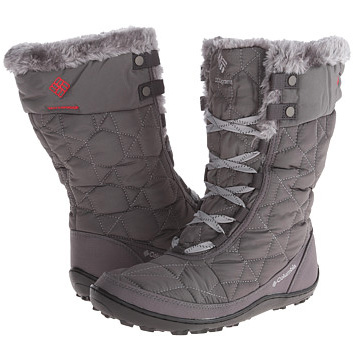 Columbia Minx Mid - Women's
Columbia Minx Mid - Women'sRated -25F/-32C, waterproof textile upper, 200g insulation + faux fur lining, traction sole In-between Bits
Eyes
Goggles in colder weather or in conditions of blowing snow to prevent snow from getting in the eyes and to cover the top part of the face. |
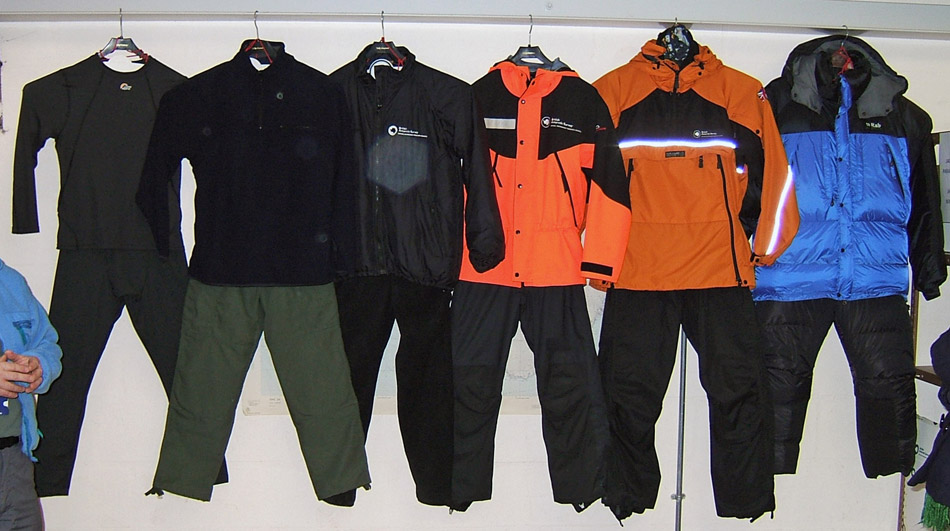
Layers of clothing for Antarctica,
underwear and insulating layers on the left
and then alternative
shells to go over these depending on conditions and activity
levels to the right.
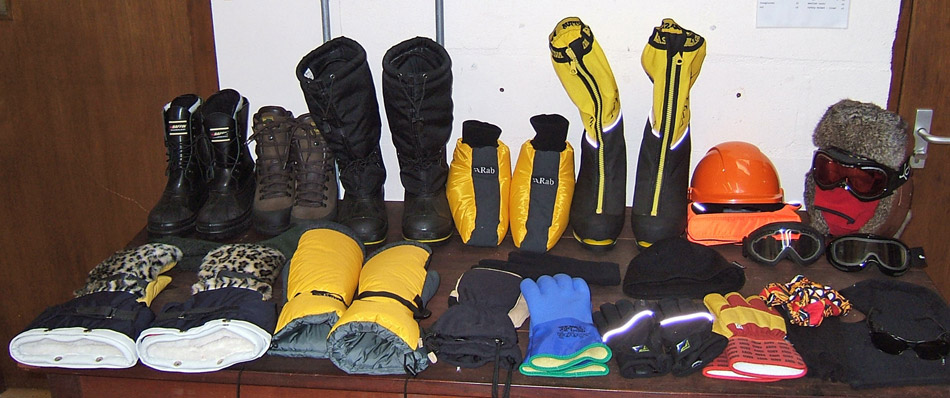
Accessories for the extremities are vital,
boots, gloves, head and eyewear for Antarctica
In the coldest
weather, the gloves and boots required become quite cumbersome
so limiting what can be achieved.
When fully dressed for extreme cold, there should be no cold-spots, there should be no way you can move around (normally) and expose flesh or just a single layer at the wrists, neck or midriff. The outer layer should be just that, the outer layer at ALL times, don't try to use an inner jacket/layer as the outside one, you'll be far too cold by the time you realise it's not working very well. With goggles on and a good hood drawn about the face and a balaclava, it is possible to have no exposed flesh at all.
Also important is to be able to vary the clothing easily, draw-cords and "pit-zips" (zips in the armpit of the shell layer) allow for ventilation when loosened / opened or insulation when pulled close, hoods, balaclavas and hats can be added or removed according to changing weather and activity.
Generally Antarctic gear appears rather too big when seen in isolation. Shirt / jacket / sweater "tails" are long, boots are chunky, mittens are long and hoods are large. Over pants in particular may seem large as they are designed to be put on when outdoors if the weather gets particularly bad. In such conditions, you can't sit down and calmly take your boots off first. The outer layers quickly go over everything underneath and then zip / draw / tie, closer to the body to keep the heat in.
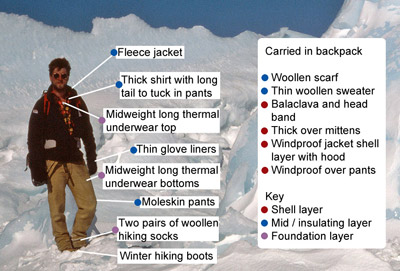
An Antarctic Scenario - layering for versatility
This is me in Antarctica on a relatively mild and calm late winters day at about -15C (+5F). The sun and lack of wind meant it felt unusually warm for a short while, with the potential for the wind to get up and temperature to go down especially when the sun started to set early in the afternoon. This is a realistic use of cold weather gear, in the worst weather it is dangerous to go far outside, so people generally stay on base.
We went out on a trip to some icebergs frozen into the sea-ice. This entailed a 3 mile very rugged overland hike to get to the edge of the sea and then more hard work over a couple of miles of broken flat sea-ice with a substantial snow covering.
This was a day of varied temperatures, changing wind speed, and different activity levels, hard uphill walking and then easier on the flat. There was always the possibility that some hardcore Antarctic weather could arrive in a pretty short time that we needed to be prepared for. The clothing had to be versatile for changing conditions and up to the job of fending off the worst the weather might bring.
Received by email
I found this site by googling "extreme cold weather
clothing" because I am sick of being stuck in the house
for three months every year when the temp drops too low
for me here. I live in Ohio and it drops to twenties and
below and often with winds and I get chilled to the bone
when I try to wait on public bussing even just for ten minutes.
I bought and wear expedition weight thermal long johns
top and bottoms, jeans, wool socks over polyester socks,
cotton polyester shirt, two fleece sweaters, a 550 fill
down classic Alaskan parka with a fleece gator and thick
gloves......AND I'M STILL COLD! My arms are the
coldest followed by my torso and then my legs.
I
can't even stand being outside for ten minutes. After
ten minutes I am chilled to the bone and start to ache....after
twenty to thirty I start to shiver. wicking sweat away??
WHAT sweat??! How do I wick away the icicles?
Any suggestions would be deeply appreciated.
Thanks.
Yes, I wear the tunnel hood secured over the high neck
of the parka covering my face from the eyes down and also
atop of the gator.
Reply
You have my sympathies, some people are just more prone
to the cold than others.
Things that spring to mind:
1 - Jeans, dreadful in the cold, in
Antarctica we used moleskin trousers, you could get lined
trousers or almost anything else, jeans are rubbish in the
cold. Looser fit is better too, tight fitting loses heat
more quickly as an outer layer.
2 - Neck
(ok sorted), wrists and ankles - are they all insulated?
Make sure clothes overlap and are insulated here.
3 - Shoes / boots - are the soles thick and
insulated? An extra insole may help if they aren't,
you can lose a lot of heat downwards.
4 -
Headwear - you don't mention anything and vitally
important, you can lose an awful lot of heat through your
head, an old saying - "If your feet are cold wear a
hat". Hoods alone can be a bit loose, a beanie or balaclava
under it can make a big difference.
5 - Wind
proofs? Is the outer layer windproof? If the wind
can get through and take heat away (like with jeans) the
effect can be significant.
6 - Heat from
the inside, are you properly fed? Your metabolism
will adjust to cold temperatures after a while and burn
fuel to warm you up - as long as it has enough fuel, it's
not a coincidence that we generally hanker after stews and
soups and hearty food in cold weather rather than summer
salads.
Paul - webmaster

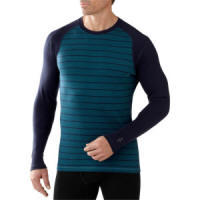
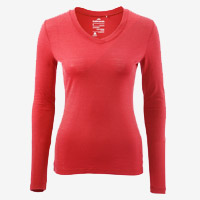
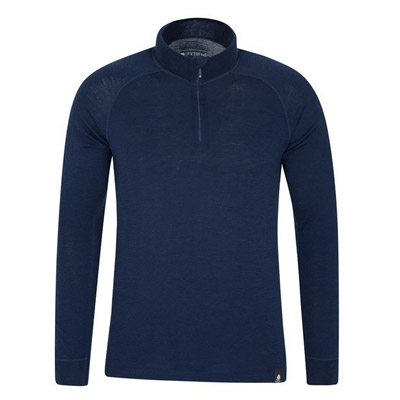 Men's
- Merino long sleeved zip neck top
Men's
- Merino long sleeved zip neck top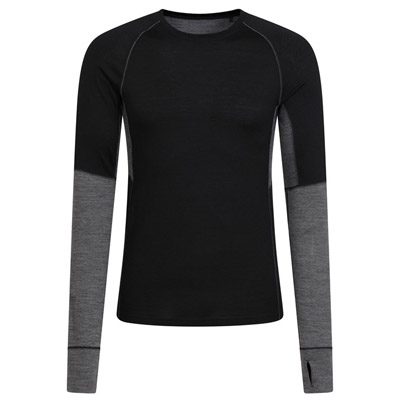 Men's
- Meriwool Ultra Merino Round Neck Top
Men's
- Meriwool Ultra Merino Round Neck Top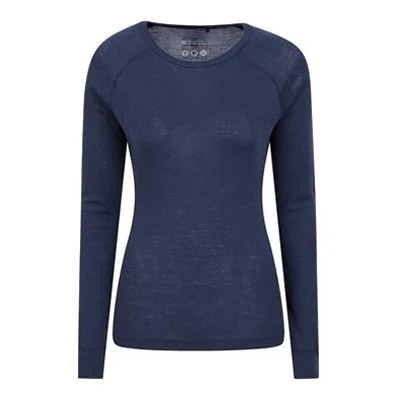 Women's
Merino Round Neck Top
Women's
Merino Round Neck Top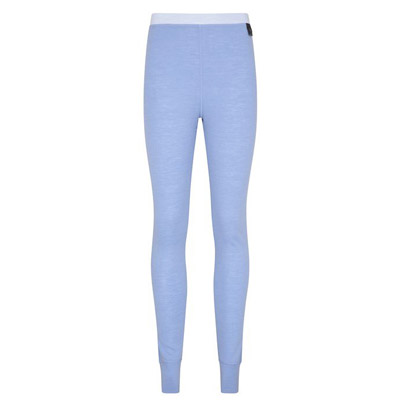 Women's
- long pants - merino wool
Women's
- long pants - merino wool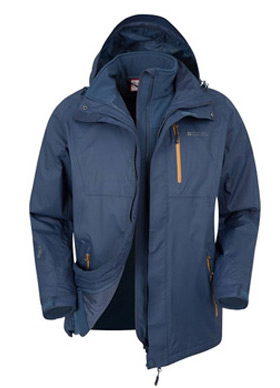

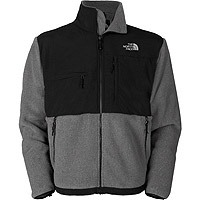
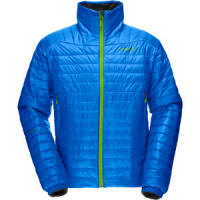
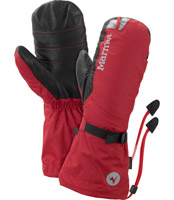
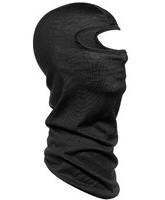

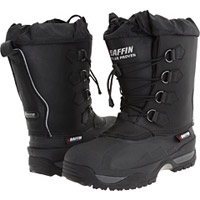
 Thermal
insoles
Thermal
insoles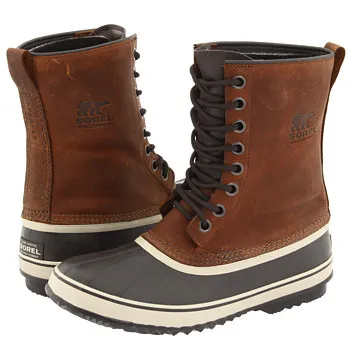 Sorel
1964 Pac Nylon Winter Boots - Men's
Sorel
1964 Pac Nylon Winter Boots - Men's Ohio
Women's Snow Boots
Ohio
Women's Snow Boots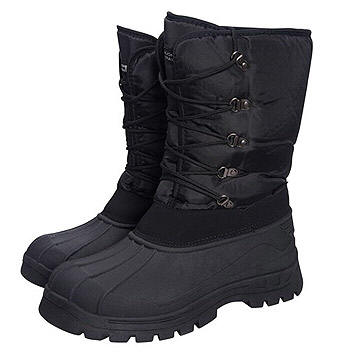 Plough
Men's Snow Boots
Plough
Men's Snow Boots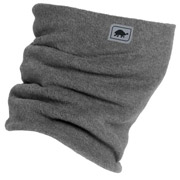
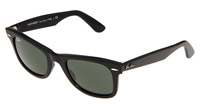 Sunglasses
Sunglasses